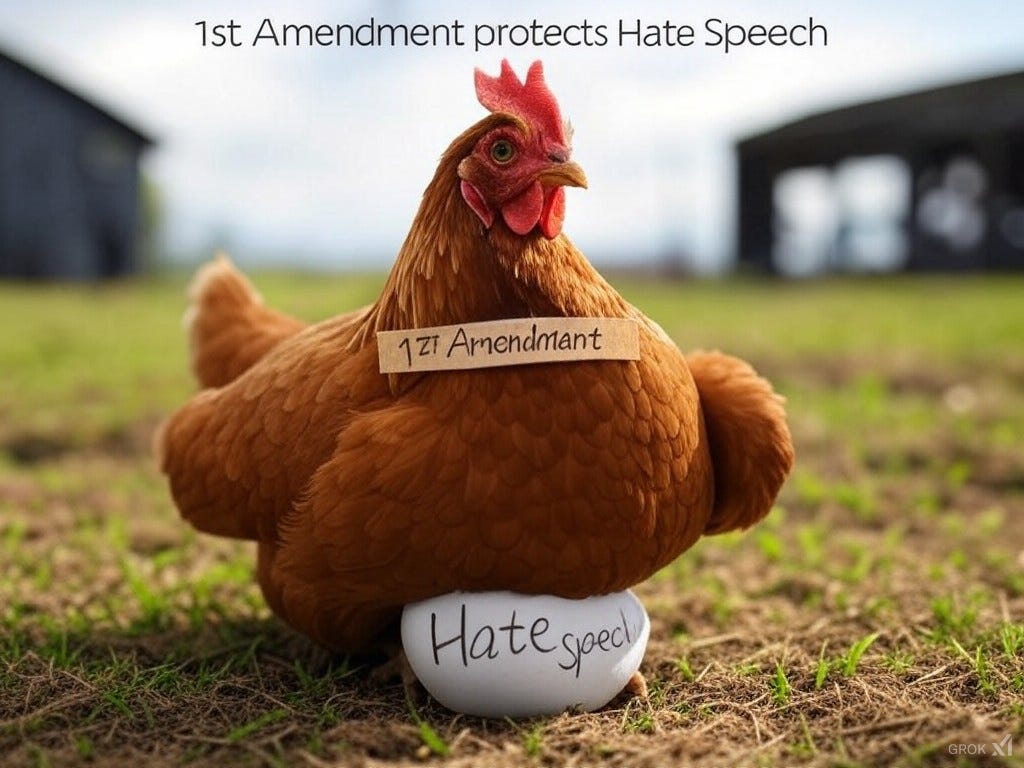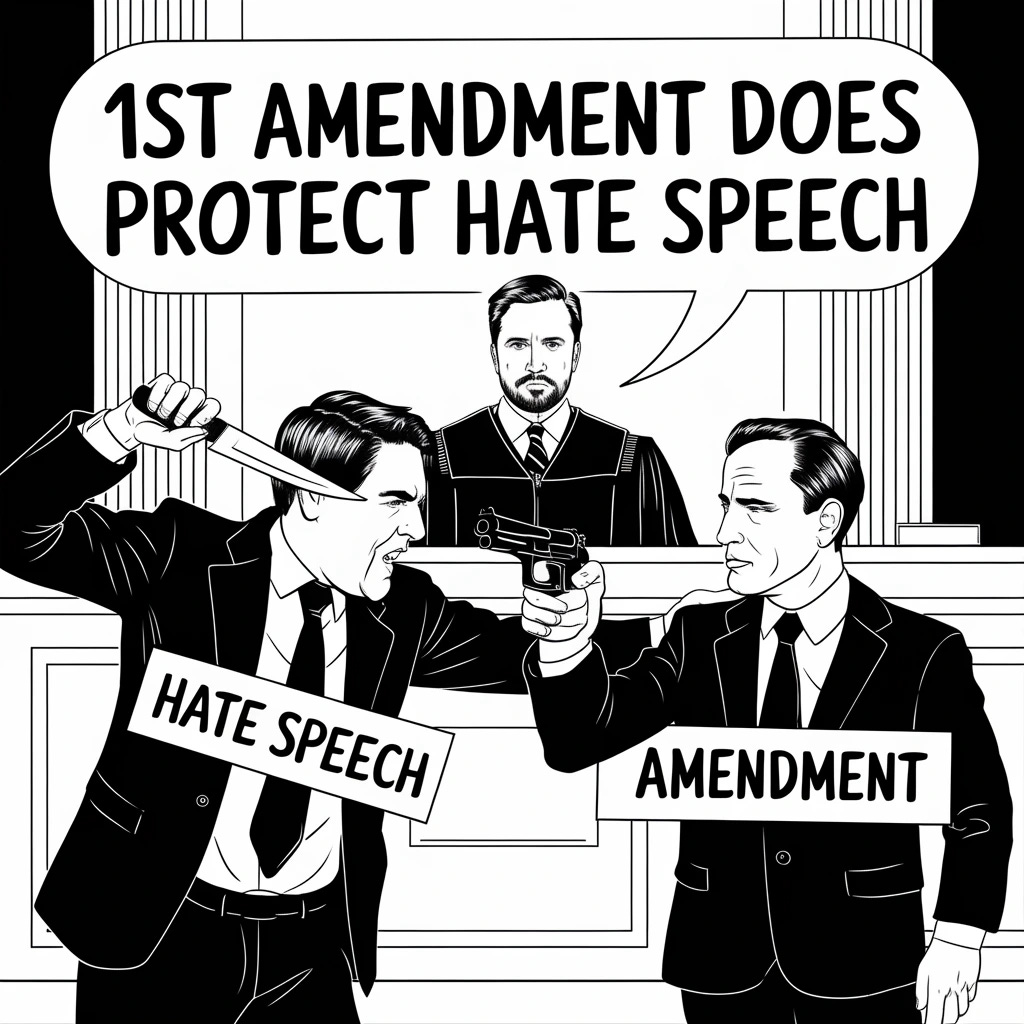What is Hate Speech?
Probably not what you think
Before we get started with this article, I’m going to define my opinion on hate speech. Except for calls to actually injure a person or group I don’t believe hate speech exists. I believe the 1st Amendment defines a freedom that I don’t choose to limit.
Are some forms or types of speech in poor taste or mean or cruel? Certainly, and in many of these cases a legal resolution is available. I just don’t believe certain words or phrases are by themselves hate speech.
The rest of this article is the result of research on what hate speech is. I don’t agree with most of it, and where I’m making a personal comment it will be in italics. Other than that I’m just the messenger...
Hate speech refers to any form of expression—spoken, written, or symbolic—that promotes hatred, violence, or discrimination against individuals or groups based on characteristics such as race, ethnicity, religion, gender, sexual orientation, disability, or nationality. It can manifest in various ways, including slurs, offensive remarks, online harassment, and propaganda advocating violence or exclusion. It often involves:
1. Direct attacks, slurs, or derogatory language targeting protected groups
2. Calls for violence or discrimination against specific groups
3. Promotion of hatred or supremacist ideologies
4. Attempts to dehumanize or demonize certain populations
Many countries have laws restricting hate speech, though approaches vary significantly. For example, many European nations have strict hate speech laws, while the United States gives broader First Amendment protection to most speech, only restricting it when it constitutes direct incitement to imminent violence.
Social media platforms and online communities typically have their own hate speech policies and moderation practices. These often prohibit content that promotes hatred or directly attacks people based on protected characteristics. Many times social media’s and online communities’ hate speech policies and moderation practices are designed to suppress one viewpoint or another.
Critics of hate speech restrictions argue they can infringe on free expression and that the term's definition can be subjective. Proponents contend that hate speech causes real harm to marginalized groups and that protecting vulnerable populations justifies some limits on expression. There is no single definition in law of what hate speech is, and the 1st Amendment protects most speech unless it is an incitement to violence, or a true threat, or harassment or intimidation, or a false statement, or what are called fighting words. In other words, the 1st Amendment protects speech unless the speech is promoting violence.
The debate continues over how to balance protecting vulnerable groups from harassment and harm while preserving freedom of expression. Different societies and platforms continue to grapple with where exactly to draw these lines.
The First Amendment of the US Constitution protects freedom of speech, including speech that is controversial or offensive. However, the Supreme Court has established certain limits, especially when speech incites violence or direct harm. Hate speech, despite its harmful nature, is mostly protected unless it falls into specific unprotected categories.
Is Hate Speech Protected Under the First Amendment?
Yes, in most cases, hate speech is protected. The US Supreme Court has repeatedly ruled that the government cannot restrict speech simply because it is offensive or hateful.
What are some Supreme Court Rulings supporting protection?
Brandenburg v. Ohio (1969) established the “imminent lawless action” test. Speech can only be restricted if it incites immediate violence or illegal action.
Snyder v. Phelps (2011) the Westboro Baptist Church was allowed to protest at military funerals with hateful signs. The Court ruled that offensive speech on public issues is protected.
Matal v. Tam (2017) where the Court struck down a law banning offensive trademarks, stating government cannot ban speech based on its viewpoint.
When is hate speech not protected?
But not when there’s violence involved
Although most hate speech is protected, the First Amendment does not protect speech that falls into these categories:
a) Incitement to Violence or Illegal Activity. Speech that directly incites or encourages immediate violence or criminal behavior is not protected. An example is Brandenburg v. Ohio (1969) where KKK speech was protected because it was not inciting immediate violence.
b) True Threats are direct threats of violence against individuals or groups that create a real fear of harm. An example is Virginia v. Black (2003) where cross-burning could be banned if done as a true threat of violence.
c) Fighting Words are face-to-face insults or speech likely to provoke immediate violence or retaliation. An example is Chaplinsky v. New Hampshire (1942) ruled that “Fighting words” that provoke immediate violence aren’t protected.
d) Harassment & Discrimination in certain contexts such as hate speech can be limited in workplaces, schools, or private institutions under civil rights laws. An example is Title VII of the Civil Rights Act prohibits hate speech in workplaces that creates a hostile environment.
That’s great, but how do courts balance hate speech and free speech?
Courts use the Strict Scrutiny Standard where if the government wants to restrict hate speech, it must show a compelling interest and use the least restrictive means possible. This uses content vs conduct to judge. The government cannot ban viewpoints, but it can regulate conduct that involves threats or harassment.
What about online hate speech and the 1st Amendment?
Social Media & Tech Companies: Platforms like Facebook, X (Twitter), and YouTube can ban hate speech because they are private companies, not government entities. If the government tries to regulate online speech, it must comply with the First Amendment.
Conclusion
Hate speech cannot be restricted just because it is offensive.
Private companies (like social media) can still choose to ban hate speech.
In closing, I maintain hate speech is a construct of modern liberalism. The 1st Amendment is clear about what you can and can’t say, and the recourse for saying something inappropriate or wrong has always been a slander (spoken) or libel (written) suit. To say that certain words are hate speech is to disregard context as well as meaning.
One example of this is use of the “N” word. If used by a white man to describe a black man it’s considered hate speech, however there is no problem if one black man uses it to describe another black man. The same goes for the pejorative “DAGO” which is a word that is just a word when one Italian uses it to describe another Italian, but is an insult and a slur when used by anyone else to describe an Italian. There are many examples that could be brought here, however the point is that without context a word is just a word.
And hate speech is a term that has no real meaning.
We can’t ask often enough that you contribute to a charity or organization that is taking care of the hurricane victims. The government certainly is less than aggressive in their disaster response and people still need help. We recommend Samaritan's Purse or Mercury One as already on the ground and doing excellent work. Thank you.






Pretty much correct, David. Thanks for the comment. It's amazing to me that speech can be protected, all speech, except that speech that irritates the commies.
Truth is the new hate speech!